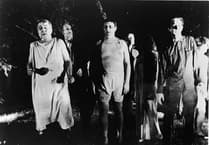A FOREST councillor claims evidence that “40,000 tonnes of American toxic weapons” were buried at Cinderford Northern Quarter during the Second World War was blocked from an official probe into the site’s regeneration.
Leading up to and during World War II, the Forest of Dean was one of the biggest storage areas for bombs, bullets and mustard gas in the UK.
And Forest of Dean District Councillor Andrew Gardiner claimed at a recent meeting that tens of thousands of toxic weapons were disposed of at the Cinderford Northern Quarter and evidence was blocked from an official inquiry.
Council chiefs conceded last month that pressing ahead with the original plan for the £100m regeneration project is “futile” due to the ballooning costs of building a new road.
They agreed a change of direction for the project after councillors conducted a review of the scheme which had originally been designed to bring 1,200 jobs, 195 homes and a new college campus on the former coalfield site.
The first stage of the project, which includes the first part of a new road and a new campus for Gloucestershire College, was completed in 2018.
But there was a £2.5 million overspend to finish the first section of the road and work for the second phase of the spine road which would have connected the site with the A4136 never began.
A scrutiny inquiry into the scheme was launched in 2021 and concluded its work earlier this year and came up with a set of recommendations which cabinet considered at their meeting in March.
But Councillor Gardiner (Independent Alliance, Mitcheldean, Ruardean and Drybrook) claims evidence submitted by a dozen people including former Home Office mining surveyors has been blocked from the report.
He told the council meeting on April 20 that ‘tens of thousands of tonnes of toxic weapons’ had been dumped at the site decades ago.
He said council chiefs were trying to “shut him up” and he has had 30 complaints against him. He asked why the evidence had been “scornfully ignored”.
“I brought [to the scrutiny inquiry] two large exhibitions of evidence we’d gathered. Not my evidence, evidence from people who gave evidence to the inquiry.
“I was asked to put on the boards, evidence from about 14 or 15 people we invited to give evidence to the inquiry, out in the corridor and I had to take the evidence out.”
Chairman Julia Gooch (Progressive Independents, Newent and Taynton) said Cllr Gardiner had an opportunity to put the evidence the northern quarter inquiry. She asked if he had a question.
He asked why he was not allowed to give that evidence at the inquiry. While he was talking he was interrupted several times by other councillors from across the chamber.
“You can do your best. If you want to shut me up like you’ve done over the years, that’s up to you,” Cllr Gardiner said.
Monitoring officer Sian Roxborough said councillors were advised at the outset that they could either be members of the inquiry or provide evidence.
She said: “They couldn’t wear both hats, so to speak. That was made clear at the outset.”
Cllr Gardiner said: “With the greatest of respect. I did have a question.
“That evidence was put out into the corridor and the chairman Nick Evans came out and examined the evidence and was very impressed. And he said that evidence has got to be put into the report.
“This is why I’ve got 30 complaints put in against me. I’m dealing with five from the cabinet right at this moment.
“You don’t do any favours by denying that you’ve got about 40,000 tonnes of American toxic weapons buried up there. I’m the one who is trying to highlight that, madam chair.”
Cllr Thom Forester (Independent Alliance) said his grandfather’s question had not been answered.
“Why was the evidence submitted by a dozen people, one of which is the most knowledgeable people on the underground mine workings, Paul Morgan former Home Office mining surveyor, not featured in the public inquiry report?”
“The officers produced a report which was basically the same old rhetoric we’ve been trotting out for the last 14 years.”
Cllr Nick Evans (C, Tidenham), who was the strategic overview and scrutiny committee chairman, said the purpose of the meeting was to review the report that had been provided by the panel.
“That is what we were doing, it was not an evidence gathering opportunity”, he said.
“Yes, I did come outside after to look at it and give you some words of advice but that was outside the meeting we were there to discuss.”




